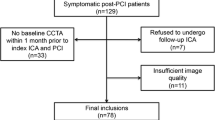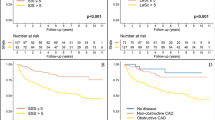Abstract
Prior studies identified the incremental value of non-invasive imaging by CT-angiogram (CTA) to detect high-risk coronary atherosclerotic plaques. Due to their superficial locations, larger calibers and motion-free imaging, the carotid arteries provide the best anatomic access for the non-invasive characterization of atherosclerotic plaques. We aim to assess the ability of predicting obstructive coronary artery disease (CAD) or acute myocardial infarction (MI) based on high-risk carotid plaque features identified by CTA. We retrospectively examined carotid CTAs of 492 patients that presented with acute stroke to characterize the atherosclerotic plaques of the carotid arteries and examined development of acute MI and obstructive CAD within 12-months. Carotid lesions were defined in terms of calcifications (large or speckled), presence of low-attenuation plaques, positive remodeling, and presence of napkin ring sign. Adjusted relative risks were calculated for each plaque features. Patients with speckled (<3 mm) calcifications and/or larger calcifications on CTA had a higher risk of developing an MI and/or obstructive CAD within 1 year compared to patients without (adjusted RR of 7.51, 95%CI 1.26–73.42, P = 0.001). Patients with low-attenuation plaques on CTA had a higher risk of developing an MI and/or obstructive CAD within 1 year than patients without (adjusted RR of 2.73, 95%CI 1.19–8.50, P = 0.021). Presence of carotid calcifications and low-attenuation plaques also portended higher sensitivity (100 and 79.17%, respectively) for the development of acute MI. Presence of carotid calcifications and low-attenuation plaques can predict the risk of developing acute MI and/or obstructive CAD within 12-months. Given their high sensitivity, their absence can reliably exclude 12-month events.
Similar content being viewed by others
Abbreviations
- ACS:
-
Acute coronary syndrome
- BMI:
-
Body mass index
- CHF:
-
Congestive heart failure
- CTA:
-
CT angiogram
- CVA:
-
Cerebrovascular accident
- DM:
-
Diabetes mellitus
- HTN:
-
Hypertension
- HLP:
-
Hyperlipidemia
- LVEF:
-
Left ventricular ejection fraction
- MI:
-
Myocardial infarction
- MRA:
-
Magnetic resonance angiogram
- NRS:
-
Napkin-ring sign
References
Buja LM, Willerson JT (1994) Role of inflammation in coronary plaque disruption. Circulation 89(1):503–505
Falk E, Shah PK, Fuster V (1995) Coronary plaque disruption. Circulation 92(3):657–671
Hoffmann U, Moselewski F, Nieman K, Jang IK, Ferencik M, Rahman AM, Cury RC, Abbara S, Joneidi-Jafari H, Achenbach S, Brady TJ (2006) Noninvasive assessment of plaque morphology and composition in culprit and stable lesions in acute coronary syndrome and stable lesions in stable angina by multidetector computed tomography. J Am Coll Cardiol 47 (8):1655–1662. doi:10.1016/j.jacc.2006.01.041
Oliver TB, Lammie GA, Wright AR, Wardlaw J, Patel SG, Peek R, Ruckley CV, Collie DA (1999) Atherosclerotic plaque at the carotid bifurcation: CT angiographic appearance with histopathologic correlation. AJNR Am J Neuroradiol 20(5):897–901
Maurovich-Horvat P, Ferencik M, Voros S, Merkely B, Hoffmann U (2014) Comprehensive plaque assessment by coronary CT angiography. Nat Rev Cardiol 11(7):390–402. doi:10.1038/nrcardio.2014.60
Maurovich-Horvat P, Hoffmann U, Vorpahl M, Nakano M, Virmani R, Alkadhi H (2010) The napkin-ring sign: CT signature of high-risk coronary plaques? JACC Cardiovasc Imaging 3(4):440–444. doi:10.1016/j.jcmg.2010.02.003
Seifarth H, Schlett CL, Nakano M, Otsuka F, Karolyi M, Liew G, Maurovich-Horvat P, Alkadhi H, Virmani R, Hoffmann U (2012) Histopathological correlates of the napkin-ring sign plaque in coronary CT angiography. Atherosclerosis 224 (1):90–96. doi:10.1016/j.atherosclerosis.2012.06.021
Otsuka K, Fukuda S, Tanaka A, Nakanishi K, Taguchi H, Yoshiyama M, Shimada K, Yoshikawa J (2014) Prognosis of vulnerable plaque on computed tomographic coronary angiography with normal myocardial perfusion image. Eur Heart J Cardiovasc Imaging 15 (3):332–340. doi:10.1093/ehjci/jet232
Nighoghossian N, Derex L, Douek P (2005) The vulnerable carotid artery plaque: current imaging methods and new perspectives. Stroke 36(12):2764–2772. doi:10.1161/01.STR.0000190895.51934.43
Alsheikh-Ali AA, Kitsios GD, Balk EM, Lau J, Ip S (2010) The vulnerable atherosclerotic plaque: scope of the literature. Ann Intern Med 153(6):387–395. doi:10.7326/0003-4819-153-6-201009210-00272
Motoyama S, Sarai M, Harigaya H, Anno H, Inoue K, Hara T, Naruse H, Ishii J, Hishida H, Wong ND, Virmani R, Kondo T, Ozaki Y, Narula J (2009) Computed tomographic angiography characteristics of atherosclerotic plaques subsequently resulting in acute coronary syndrome. J Am Coll Cardiol 54(1):49–57. doi:10.1016/j.jacc.2009.02.068
Ehara S, Kobayashi Y, Yoshiyama M, Shimada K, Shimada Y, Fukuda D, Nakamura Y, Yamashita H, Yamagishi H, Takeuchi K, Naruko T, Haze K, Becker AE, Yoshikawa J, Ueda M (2004) Spotty calcification typifies the culprit plaque in patients with acute myocardial infarction: an intravascular ultrasound study. Circulation 110(22):3424–3429. doi:10.1161/01.CIR.0000148131.41425.E9
Adams RJ, Chimowitz MI, Alpert JS, Awad IA, Cerqueria MD, Fayad P, Taubert KA (2003) Coronary risk evaluation in patients with transient ischemic attack and ischemic stroke: a scientific statement for healthcare professionals from the Stroke Council and the Council on Clinical Cardiology of the American Heart Association/American Stroke Association. Circulation 108(10):1278–1290. doi:10.1161/01.CIR.0000090444.87006.CF
Touze E, Varenne O, Chatellier G, Peyrard S, Rothwell PM, Mas JL (2005) Risk of myocardial infarction and vascular death after transient ischemic attack and ischemic stroke: a systematic review and meta-analysis. Stroke 36(12):2748–2755. doi:10.1161/01.STR.0000190118.02275.33
Howard G, Anderson R, Sorlie P, Andrews V, Backlund E, Burke GL (1994) Ethnic differences in stroke mortality between non-Hispanic whites, Hispanic whites, and blacks. The National Longitudinal Mortality Study. Stroke 25(11):2120–2125
Kittner SJ, White LR, Losonczy KG, Wolf PA, Hebel JR (1990) Black-white differences in stroke incidence in a national sample. The contribution of hypertension and diabetes mellitus. JAMA 264(10):1267–1270
Motoyama S, Kondo T, Sarai M, Sugiura A, Harigaya H, Sato T, Inoue K, Okumura M, Ishii J, Anno H, Virmani R, Ozaki Y, Hishida H, Narula J (2007) Multislice computed tomographic characteristics of coronary lesions in acute coronary syndromes. J Am Coll Cardiol 50(4):319–326. doi:10.1016/j.jacc.2007.03.044
Voros S, Rinehart S, Qian Z, Joshi P, Vazquez G, Fischer C, Belur P, Hulten E, Villines TC (2011) Coronary atherosclerosis imaging by coronary CT angiography: current status, correlation with intravascular interrogation and meta-analysis. JACC Cardiovasc Imaging 4(5):537–548. doi:10.1016/j.jcmg.2011.03.006
Ito T, Terashima M, Kaneda H, Nasu K, Matsuo H, Ehara M, Kinoshita Y, Kimura M, Tanaka N, Habara M, Katoh O, Suzuki T (2011) Comparison of in vivo assessment of vulnerable plaque by 64-slice multislice computed tomography versus optical coherence tomography. Am J Cardiol 107(9):1270–1277. doi:10.1016/j.amjcard.2010.12.036
Wilson PW, D’ Agostino RB, Levy D, Belanger AM, Silbershatz H, Kannel WB (1998) Prediction of coronary heart disease using risk factor categories. Circulation 97(18):1837–1847
Greenland P, LaBree L, Azen SP, Doherty TM, Detrano RC (2004) Coronary artery calcium score combined with Framingham score for risk prediction in asymptomatic individuals. JAMA 291(2):210–215. doi:10.1001/jama.291.2.210
Fujimoto S, Kondo T, Takamura K, Baber U, Shinozaki T, Nishizaki Y, Kawaguchi Y, Matsumori R, Hiki M, Miyauchi K, Daida H, Hecht H, Stone GW, Narula J (2016) Incremental prognostic value of coronary computed tomographic angiography high-risk plaque characteristics in newly symptomatic patients. J Cardiol 67(6):538–544. doi:10.1016/j.jjcc.2015.07.018
Nadjiri J, Hausleiter J, Jahnichen C, Will A, Hendrich E, Martinoff S, Hadamitzky M (2016) Incremental prognostic value of quantitative plaque assessment in coronary CT angiography during 5 years of follow up. J Cardiovasc Comput Tomogr 10(2):97–104. doi:10.1016/j.jcct.2016.01.007
Acknowledgements
Research reported in this publication was supported by the National Center for Advancing Translational Sciences of the National Institutes of Health under award Number Kl2TR001413. The content is solely the responsibility of the authors and does not necessarily represent the official views of the NIH.
Author information
Authors and Affiliations
Corresponding author
Ethics declarations
Disclosures
None.
Additional information
Wassim Mosleh and Keenan Adib have contributed equally to this work.
Electronic supplementary material
Below is the link to the electronic supplementary material.
Rights and permissions
About this article
Cite this article
Mosleh, W., Adib, K., Natdanai, P. et al. High-risk carotid plaques identified by CT-angiogram can predict acute myocardial infarction. Int J Cardiovasc Imaging 33, 561–568 (2017). https://doi.org/10.1007/s10554-016-1019-5
Received:
Accepted:
Published:
Issue Date:
DOI: https://doi.org/10.1007/s10554-016-1019-5




